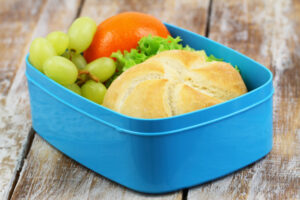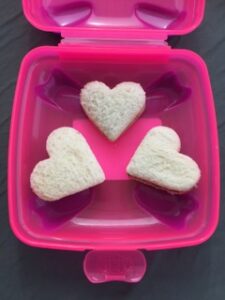Blog
The Lunchbox Challenge!
The Lunchbox Challenge!
Does your child take the same food to school every day? Is their lunchbox a sea of beige? Do they eat little or no fruit or vegetables at school? Does food frequently come home uneaten?
Packing a lunch box every day for a child who has a very limited range of foods, can be disheartening to say the least. There are so few foods to choose from that most days, or every day, their lunchbox looks the same. All attempts to send a new food, in the hope that they will eat it, end in disappointment.
 So how do we get to a lunch box that looks more like this?
So how do we get to a lunch box that looks more like this?
The answer: Slowly! Small steps. Small changes. I frequently say, “As long as we are headed in the right direction, no matter how small the steps, we will get there eventually.”
Here are five easy to follow tips to start on the road to a lunch box that has more variety, and maybe even a piece of fruit!
1. Vary the foods that your child already eats happily
The first step is to make the lunch box look a bit different everyday by varying foods that they already eat happily.
If your child takes a Vegemite sandwich everyday but will also eat Vegemite on a roll, start by alternating these two for lunch.
Choose three or four snack foods that they already eat and vary these across the week.
If the lunchbox looks a little bit different every day, it will help with the next step where you start to add foods that are just a little bit different to the foods they usually eat.
2. Expand the variety of safe foods first
The next step is to introduce more variety within the range of foods they already eat.
 This might be a different brand of bread. Keep steps small, so not a multigrain if they only eat white bread but maybe another brand of white bread or a smooth wholemeal. It could be a different shape or type of roll or a different flavour of cracker.
This might be a different brand of bread. Keep steps small, so not a multigrain if they only eat white bread but maybe another brand of white bread or a smooth wholemeal. It could be a different shape or type of roll or a different flavour of cracker.
Try these foods at home first. Surprises in the lunch box will usually still be there when the lunchbox comes home.
If you have success with these at home, add them into the lunch box rotation. Slowly the lunchbox is starting to look a little different every day.
3. Send less volume of food
Less is more! If food is coming home every day, pack less food – they are not eating it anyway.
Parents often tell me that they pack a large range of foods in the hope that their child will at least eat something. Large volumes and large variety can be overwhelming when your relationship with food is already a bit shaky.
If you pack a food every day and it comes home every day, stop packing it.
4. Work on fruit or vegetables at home first
 Fruit and vegetables can be very challenging for some children. They are brightly coloured, wet, soft and some have a strong smell. They can be very overwhelming for a child whose lunchbox is usually filled with beige, dry and crunchy foods.
Fruit and vegetables can be very challenging for some children. They are brightly coloured, wet, soft and some have a strong smell. They can be very overwhelming for a child whose lunchbox is usually filled with beige, dry and crunchy foods.
Take fruit and vegetables slowly. Work on them at home first. Spend time talking about fruits and vegetables, touch them, and explore them without any expectation of eating them.
If you do put a new fruit or vegetable into a lunchbox, warn your child that it is going to be there, keep the volume small and don’t expect that they will eat it straight away.
5. Deconstruct the lunch
There is no rule that says bread has to have a filling. If your child eats cheese, ham, chicken or sausage, but does not like these on bread, send plain bread or a roll and send the ‘filling’ separately.
 You can do the same with a wrap, plain pasta or rice. A small thermos of warm plain pasta in winter is a big hit in our house.
You can do the same with a wrap, plain pasta or rice. A small thermos of warm plain pasta in winter is a big hit in our house.
Most importantly, take things slowly, include your child in making changes to their lunch box and remember that small steps forward are steps in the right direction.
I would love to hear your top lunch box tips.